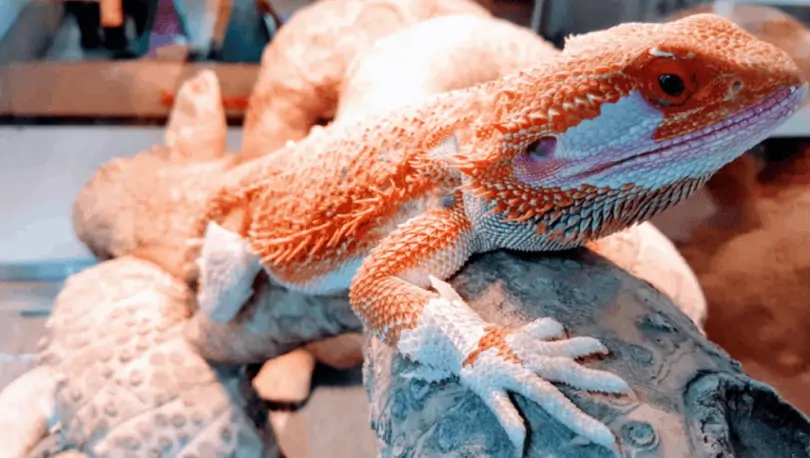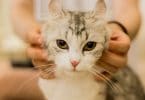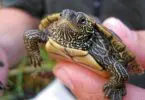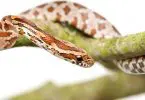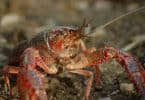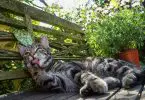Shedding is one of the most common natural processes in reptiles. Shedding means removing/ casting off the outer layer of connective tissue (skin) and producing a new one by the serpents. The shedding method is the normal one and is also known as sloughing, molting, and peeling.
After shedding, brighter and better colors appear, and your beardie looks more vibrant than before. Scientifically we call this mechanism ecdysis and cannot explain it in a few simple steps. However, in simpler words, ecdysis is a process of producing a brand new skin naturally to remove the thin dead layer that may offer less protection
On completing newer versions of skin, the older one is removed with a complex burst of enzymes. Different reptiles have a different pattern of losing their fur. Some such as snakes leave a full cast when they move; however, lizards such as bearded dragons shed in flakes. That’s why the appearance will appear a lot more patchy for a short time.
Table of Contents
Do Bearded Dragons Shed Their Skin?
Yes, the bearded dragon does shed their skin. This behavior is entirely normal and natural. A one-year-old bearded dragon shed every 6 to 8 weeks.
The frequency of shedding is a lot more in juvenile bearded dragons than in adults. However, age does not have any visible correlation with the shedding process of the bearded dragon.
If you look into the exact frequency and timing for shedding in bearded dragon, the answer will be vague. Most of the owners of bearded dragons and vets agree upon the fact that bearded dragons have a random pattern of shedding. Moreover, it is induced by certain factors more commonly. However, remember that bearded dragons always shed in patches, and it is entirely normal for them to have flaky skin as they can be in the process of shedding.
However, if your bearded dragon shows persistent flaky skin, you must contact your vet for a chance of skin infection. Moreover, try to hydrate the skin of your bearded dragon a lot more than usual.
Let us discuss the factors that cause the bearded dragon to shed.
The Shedding Process In Your Bearded Dragon
You must have heard a lot of myths about shedding. Some may say it is proof of growth, while others insist on hormonal changes. However, the process of molting in bearded dragons is very much different from invertebrates. In invertebrates, shedding is related to growth; however, in bearded dragons and other vertebrates, there can be the following causes.
- Environmental changes
- Age
- Diet
- Habit
- Stress
- UVB levels
Let us discuss all of the above factors one by one
Environmental Changes
Humidity in the environment provokes the shedding process. Whenever there is more moisture, it causes your bearded dragon to shed the last dry, dead skin cells and regenerate new ones. It is always recommended that you start misting with water as soon as you see your bearded dragon start shedding.
Age
Age is not always the reason behind shedding. However, it is seen that the juvenile bearded dragon shed a lot more than an adult or old one. Because their body is developing and they need to maintain it With age, the frequency of shedding may reduce to a minimum to none. Sometimes body growth in bearded dragons does play a stimulatory part. However, in the actual process, they do not have quite a visible role. Actually, with age, a surge of growth hormones induces the process of ecdysis. However, other factors, e.g., calcium depletion, may also play a role in stimulating the revolution.
Therefore, if you see your beardie eating up its old skin, do not worry. However, it is entirely safe; fear for the fact that your little friend lacks calcium. So, add calcium supplements to its diet.
Diet
Calcium is the most significant cause of the shedding of the skin by bearded dragons. So, if your beardie is shedding a lot, make sure to consult your vet and include calcium supplements in its diet. However, it is not always related to diet too! As humans, we are also shedding all the time. However, we do it cell by cell, which reaches millions of cells. Therefore, it is not very visible. In the animal world, shedding is related to sloughing off skin in patches or one piece. So, it is quite normal for bearded dragons to shed as they feel for shedding.
Habit
Habit and habitat are two different terminologies. Both affect the shedding process of the bearded dragon a lot. For example, in moisture, the bearded dragon tends to shed a lot more than usual as it is a lot easy to shed in the presence of a hydrated environment. Moreover, if a bearded dragon is habitual of shedding at a specific time of the year, it will free irrespective of any reason. It also depends on which environment or habitat the bearded dragon originally belonged to and what behavior is coded in the genes.
Stress
Stress or anxiety situations that any process may trigger can lead to shedding in bearded dragons. Stress can be induced by the entry of rival, lack f food, moisture, other nutrients, etc. Stress can cause much frequent shedding in reptiles to face the situation in a better way.
UVB Levels
If the bearded dragon is exposed to low UVB levels, it causes hypocalcemia, leading to stress in the body. All this collectively plays an active role in the molting process.
Cutting it short, you can never be very sure of the repetitive pattern or time of shedding your bearded dragon. Shedding depends on the factors mentioned above, such as age, habitat, diet, etc., which can influence the process differently.
When we talk about shedding, a question arises. Is it okay for your beardie to shed? Is it losing vital nutrients through this? Does this process has any benefits?
So the answer to all these questions will be cleared as we discuss the benefits of sedding in bearded dragons.
Benefits Of Shedding
Shedding is a process in reptiles to ave multiple benefits. Some of the services are given as:
- Remove parasites
- Better UVB absorption
- Better calcium levels.
- Better protection
Remove Parasites
Lorem ipsum dolor sit amet, consectetur adipiscing elit. Ut elit tellus, luctus nec ullamcorper mattis, pulvinar dapibus leo.
Shedding removes harmful parasites in bearded dragons. Naturally, a bearded dragon senses a deadly creature on its epidermis and cannot get rid of it quickly. Most bearded dragons suffer from mites and shed their skin to get rid of them. If you are using any topical antiprotozoals, antihelminthic, or antimicrobials for your bearded dragon and start shedding during this time, stop the use with your vet’s consent. Being precise, prevent the use of all kinds of the topical agent during the shedding process. The skin is more prone to absorbing toxic materials in the dosage form or absorbing the drug more, making it reach toxic levels.
Better UVB Absorption
New skin in bearded dragons shows better UVB absorption than the previous one. The cells capturing UV light and producing vitamin D2 in the body, as a result, are more active in the new skin. So, if you see your bearded dragon shedding, you do not need to add extra supplementation of D2 in the diet.
Better Calcium Levels
As Vitamin D levels increase in the body, they cause the blood and bone calcium levels to rise. Be very careful in calcium supplementation as your bearded dragon has shed recently. Extra supplementation can lead to a condition called hypercalcemia, in which the blood calcium rises above normal calcium.
Better Protection
New skin offers much better protection than older ones. The defense can be from stress, harmful weather conditions, and so on. Usually, bearded dragons shed before the harsh weather to make themselves ready to face it.
Signs Of Shedding
Now, let’s discuss the most common signs you see in the bearded dragons when they start shedding.
Some of the most common signs during the shedding process are:
- Lethargy: Bearded dragon shows lazy behavior. They like to stay still and do not move a lot while shedding. You may feel they are a bit ill, but that’s entirely normal for bearded dragons to exhibit such behavior while shedding.
- Loss Of Appetite: It is the most common symptom of shedding in bearded dragons. Your lizard will lose appetite and do not like to eat even if you force. Many bearded dragon owners report that bearded dragons stop eating any veg parts and crave a lot more for sugars when they are in the process of shedding. If your bearded dragon is also showing such behavior, be careful about the diet and maintain the sugar part as the increase in it may be harmful.
- Skittish behavior: Skittish and weak behavior is expected in bearded dragons undergoing the process of shedding as the skin of the bearded dragon is renovating and is soft, so they become more vulnerable—the behavior changes as they grow and skin hardens.
- Not wanting to be handled: Another typical behavior while shedding is running from handling. The bearded dragon gets irritated and feels vulnerable when their owner comes near them. So, it is better to let them be during the whole process. Remember, do not do anything that can cause agitation. The response can be harmful to both of you then.
- Raised patches of skin: Raised skin patches show the process of shedding. If you observe so, do not get panic. Just remember to hydrate the skin and let your bearded dragon complete the process at its own pace.
- Eye inflation: The bearded dragon shows how their eye sewel and skin get loose around their eyes when they start shedding. The eyes are the first areas to molt, so their skin loosens up at first. Inflation of eyes may be regarded as the first sign of losing in bearded dragons.
Certain other behaviors are manifested after completion of the shed. They are to remove the dead skin and give new skin complete exposure to the atmosphere.
- Rubbing the bodies against rocks, branches, or bark to loosen skin
- Repetitive scratching of the bodies with their legs
- Rubbing the bodies against rough surfaces
As an owner of a beautiful bearded dragon, you may assist your friend in removing its skin. Many bearded dragon owners like to place shallow baths or sandstone slabs inside their pet’s living area. These hard surfaces provide a place where they can rub their bodies to remove their skin easily. However, do not go overboard!
Never try to pick the skin or pluck it away by hand deliberately. It can result in severe infection or injury to your beardie.
How Long It Takes To Shed For A Bearded Dragon?
Different reptiles take different times to shed. However, if we talk typically about bearded dragons, they may take 2 to 3 whole weeks to complete the process.
In juvenile bearded dragons, the whole time to complete is even shorter. Baby bearded dragons may take up to a week to complete the entire process.
However, in the case of a juvenile bearded dragon, you need to pay extra attention to the skin’s old ruminants. These remnants may cause severe blood flow restrictions and inflammations. All these issues are serious, including tail rot.
How To Help The Bearded Dragon While Shedding The Skin?
You can never pick or remove the old skin of your bearded dragon on your own. However, there are many other ways in which you can help your friend in this process.
On Amazon, you may see a lot of products that might help your bearded dragon in shedding. However, these are mostly plucking devices and other shedding products. I never recommend using them on the first line. However, if you find all the techniques ineffective and your vet recommends them too, you may use them in the last choice. You may accidentally damage the new skin or handle the older one carelessly, which may cause severe damage and infection to your bearded dragon.
Following are the some most effective techniques that are going to help your bearded dragon in its shedding process:
Use Moisture
The best thing that can aid in the shredding process is moisture. Always keep your dragons skin hydrated. There are several ways of doing so:
Bathing
Baths provide a lot more softening and hydrating effect to the skin than any other method. Include more frequent baths in the routine of your bearded dragon. You may put water in a small plastic bin or draw water in your skin and let your beardie enjoy and feel comfortable. However, if you are using the bathing in sink method, beware of the faucet. Never leave it running as it will be forcing the unready skin.
Misting
Misting your bearded dragon with water is another way to hydrate the skin. In the better grooming of bearded dragons, regular misting is a part of the daily routine. But when you see your beardie shedding, double or triple the frequency. The best way is to mist frequently with the help of a light shower.
While bathing or misting, try not to use any other agent in the water. Moreover, ensure that water is very close to the average body temperature. The best way is to use purified water instead of tap water. The skin is very prone to parasites, insects, and other agents during the shedding process. Moreover, tap water also contains a lot of chlorine which can cause severe irritation to your bearded dragon.
Use A Shedding Helper
There are multiple products in the market that help your bearded dragon in the shedding process. One of the best ones I found in the market is Zoo Med Repti Shedding Aid. It helps you with all the kind of reptiles. It simultaneously conditions the skin and also encourages the dead skin beneath to fall away. You may add it in bathing water to provide an extra smoothening effect to the epidermis of your beardie. However, never apply it directly to your bearded dragon’s skin as it is too potent for the new skin in this way.
Quick Summary
Here is a quick summa of the whole article:
- Shedding does not depend on age. However, juvenile bearded dragons shed a lot more than adult ones. Moreover, the older bearded dragons shed infrequently and in patches.
- Shedding is not an immediate process. Every bearded dragon has its own time. So, be patient with your bearded dragon and do not try to interrupt the whole process in any way.
- A bearded dragon may take up to three weeks to shed and may appear sluggish during the whole time. Do not worry and let it be. However, if the shred takes more than four weeks, you need to consult your vet
- Shedding aids are prevalent nowadays. However, you should only consider their use as a last choice. Mild shedding aids are the best, as mentioned above.
- The best way to aid in shedding is to hydrate the skin often.
- Shedding is not harmful. Instead, it is the best way to keep your friend healthy and protected from environmental damage.
- Never try to peel the skin from the dragon on your own. However, if you see so in a juvenile bearded dragon, contact your vet.
- You may see lethargy, loss of appetite, and violent behaviors while shedding. Do not worry. These are entirely normal for your bearded dragon.
Let me repeat, do not worry. Your friend is lovely and enjoying their time. Mostly it will never develop any complication. However, you can keep a close eye in case of any mishappening. Just go well with food and hydration during the whole period, and nothing will go wrong. If you may drop off the comment or contact us in case of any other query, we will be delighted to help.


